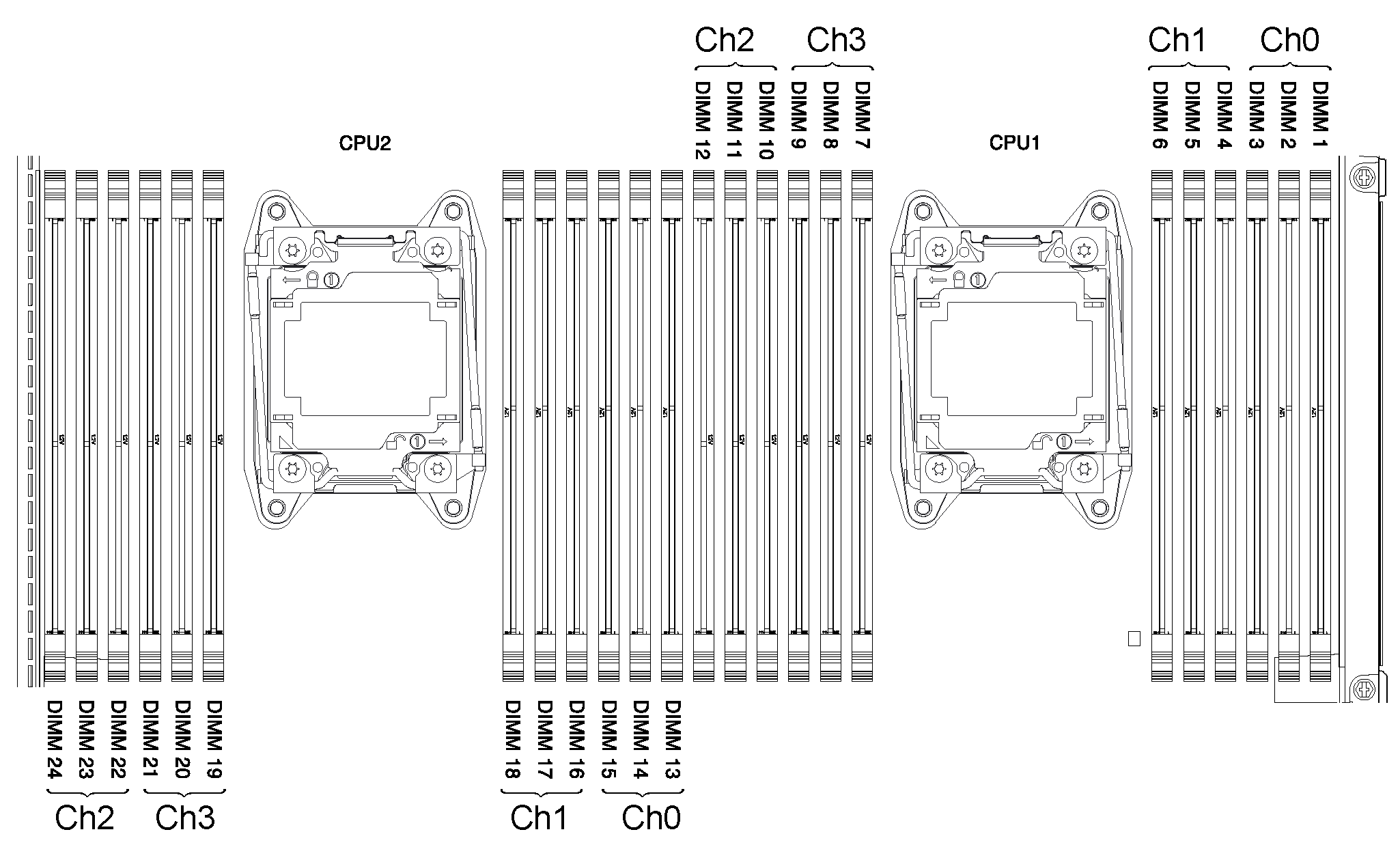Memory module installation
The following notes describe the types of DIMMs that the server supports and other information that you must consider when you install DIMMs.
- When you install or remove DIMMs, the server configuration information changes. When you restart the server, the system displays a message that indicates that the memory configuration has changed.
- The server supports only industry-standard double-data-rate 4 (DDR4) 2400 MHz PC4-19200 registered or load reduction, synchronous dynamic random-access memory (SDRAM) dual inline memory modules (DIMMs) with error correcting code (ECC). See the Lenovo ServerProven website for a list of supported memory modules for the server.
- The specifications of a DDR4 DIMM are on a label on the DIMM, in the following format.
gggggeRxff PC3v-wwwwwm-aa-bb-ccd
where:- ggggg is the total capacity of the DIMM (for example, 1 GB, 2 GB, or 4 GB)
- eR is the number of ranks
- 1R = single-rank
- 2R = dual-rank
- 4R = quad-rank
- xff is the device organization (bit width)
- x4 = x4 organization (4 DQ lines per SDRAM)
- x8 = x8 organization
- x16 = x16 organization
- v is the SDRAM and support component supply voltage (VDD)
- Blank = 1.2 V specified
- wwwww is the DIMM bandwidth, in MBps
- 12800 = 12.80 GBps (DDR4-1600 SDRAMs, 8-byte primary data bus)
- 14900 = 14.93 GBps (DDR4-1866 SDRAMs, 8-byte primary data bus)
- 17000 = 17.00 GBps (DDR4-2133 SDRAMs, 8-byte primary data bus)
- 19200 = 19.20 GBps (DDR4-2400 SDRAMs, 8-byte primary data bus)
- m is the DIMM type
- L = Load Reduction DIMM (LRDIMM)
- R = Registered DIMM (RDIMM)
- aa is the CAS latency, in clocks at maximum operating frequency
- bb is the JEDEC SPD Revision Encoding and Additions level
- cc is the reference design file for the design of the DIMM
- d is the revision number of the reference design of the DIMM
NoteTo determine the type of a DIMM, see the label on the DIMM. The information on the label is in the format xxxxxnRxxx PC3v-xxxxxx-xx-xx-xxx. The numeral in the sixth numerical position indicates whether the DIMM is single-rank (n=1), dual-rank (n=2), or quad-rank (n=4). - The specifications of a DDR4 DIMM are on a label on the DIMM, in the following format.
- The following rules apply to DDR4 RDIMM speed as it relates to the number of RDIMMs in a channel:
- When you install 1 RDIMM per channel, the memory runs at 2400 MHz.
- When you install 2 RDIMMs per channel, the memory runs at 2400 MHz.
- When you install 3 RDIMMs per channel, the memory may run at 1866 MHz.
- All channels in a server run at the fastest common frequency.
- Do not install registered, unbuffered, and load reduction DIMMs in the same server.
- The maximum memory speed is determined by the combination of the microprocessor, DIMM speed, DIMM type, Operating Modes in UEFI settings, and the number of DIMMs installed in each channel.
- In two-DIMM-per-channel configuration, the server automatically operates with a maximum memory speed of up to 2400 MHz when the following condition is met:
- Two 1.35 V single-rank, dual-rank, or quad-rank RDIMMs or LRDIMMs are installed in the same channel. In the Setup Utility, Memory speed is set to Max performance and LV-DIMM power is set to Enhance performance mode. The 1.35 V RDIMMs or LRDIMMs will function at 1.5 V.
- The server supports a maximum of 24 single-rank, dual-rank RDIMMs or 24 quad-rank LRDIMMs.
It is recommended to install DIMMs with the same rank in each channel.
- The following table shows an example of the maximum amount of memory that you can install using RDIMMs or LRDIMMs:
Table 1. Maximum memory installation. Four column table for documenting the number of DIMMs, DIMM type, size, and total memory.
Number of DIMMs DIMM type Size Total memory 24 Single-rank RDIMM 8 GB 192 GB 24 Dual-rank RDIMM 8 GB 192 GB 24 Dual-rank RDIMM 16 GB 384 GB 24 Dual-rank RDIMM 32 GB 768 GB 24 Quad-rank LRDIMM 64 GB 1536 GB - The RDIMM options that are available for the server are 8 GB, 16 GB, and 32 GB. The server supports a minimum of 8 GB and a maximum of 768 GB of system memory using RDIMMs.
- The LRDIMM option that is available for the server is 64 GB. The server supports a minimum of 64 GB and a maximum of 1536 GB of system memory using LRDIMMs.NoteThe amount of usable memory is reduced depending on the system configuration. A certain amount of memory must be reserved for system resources. To view the total amount of installed memory and the amount of configured memory, run the Setup Utility. For additional information, see
Configuring the server. - A minimum of one DIMM must be installed for each microprocessor. For example, you must install a minimum of two DIMMs if the server has two microprocessors installed. However, to improve system performance, install a minimum of four DIMMs for each microprocessor.
- DIMMs in the server must be the same type (RDIMM or LRDIMM) to ensure that the server will operate correctly.
- When you install one quad-rank DIMM in a channel, install it in the DIMM connector furthest away from the microprocessor.Note
- You can install DIMMs for microprocessor 2 as soon as you install microprocessor 2; you do not have to wait until all of the DIMM slots for microprocessor 1 are filled.
- DIMM slots 13-24 are reserved for microprocessor 2; thus, DIMM slots 13-24 are enabled when microprocessor 2 is installed.
Read the following table before installing memory modules when any NVIDIA adapter is installed.
Table 2. NVIDIA video adapter configurations Description Supported maximum total memory size NVIDIA Quadro K420, K600, and K620 1 TB
The following illustration shows the location of the DIMM connectors on the system board.
Figure 1. DIMM connectors location


Give documentation feedback